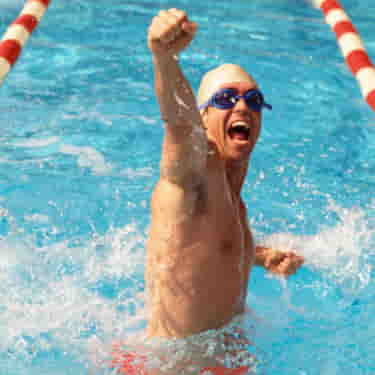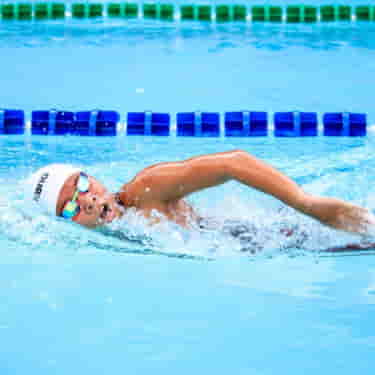Swim times can drive swimmers crazy. Are we swimming fast enough? How do we measure up to our peers?
One of the most common swim times that we get obsessed about is how long it takes to swim a mile.
When starting out on your swimming journey, a time will come when you hit the one-mile swim milestone. This is a fantastic achievement and it can be very motivating (or just interesting to know) how long it takes to swim a mile on average.
As a general rule, the average one-mile swim time for a beginner is between 45mins and 55mins. For intermediate swimmers, a typical one-mile average swim time is between 35mins and 40mins. Expert swimmers can typically swim one mile in a time of less than 30mins.
In this article I will investigate:
- The average time to swim a mile in a pool.
- How many pool swim lengths are in one mile?
- How to swim one mile faster?
- What is the average time to swim a mile using breaststroke?

How Long Does It Take To Swim A Mile?
Nothing beats that moment when you first swim a mile. It does not matter if you stopped on every pool length, the fact that you stayed in the water and covered one mile is worth celebrating.
I remember the first time I swam a full mile in one swim session and I felt on top of the world. I stared at my Fitbit in awe!
The fun only starts there, as next comes the opportunity to improve your swim times and speeds.
A mile is a good distance to benchmark against, as it is a universally understood distance.
How Long To Swim A Mile In A Pool
All body sizes, shapes and cardio ability will produce different swim times so there is no absolute figure to work towards. As a result, we must take a general average to work out how long it takes to swim a mile.
The following is a combination of data listing the average time to swim a mile in an hour in a swimming pool.
| SWIM STROKE | BEGINNER | INTERMEDIATE | EXPERT |
| FREESTYLE | 40mins – 60mins | 25mins – 40mins | 15mins – 25mins |
Outdoor open water swim times and swimming in the ocean will have different average one-mile swim times. This is because of external outdoor factors such as wind, tides and the lack of a pool wall. Kicking from a pool wall on every length can help swimmers go faster. Therefore, this data applies to pool swimming only.
I compiled this data from the US Masters Swimming swim meets and events results database. [source]
There is little point in comparing yourself to an expert swimmer if you are a beginner, so I have divided the data up into swim skill levels.
At first, I divided the data into age and gender to further refine the times, however, there was such little difference in swim times I disregarded this approach.
It is clearer to display the data with just beginner, intermediate and expert – with expert being defined as the top tenth percentile of swimmers.
For example, looking at some data averages for a men’s 65 plus age group swim meet event, the top swimmers were recording times between 19 minutes and 25 minutes.
If you are slower than you thought, don’t get discouraged. This is just a general guide as everyone varies.
How Many Pool Swim Lengths Are In One Mile?
It is also worth noting that they based the above data on a US swim mile, which is actually 1,650 yards.
There are 1,760 yards in a mile, so remember they based these swim times on a slightly shorter length than a standard mile.
The United States uses the imperial measurement system (inches/miles) but most of the world, including the Olympics, use the metric system (cm/meters). A popular Olympic swim competition length is 1500m, therefore US athletes swim 1650 yards in training as this is close to this distance.
| 1 MILE | 1609 METERS | 1760 YARDS |
The following is the number of lengths in a mile if you are swimming in a 25-meter or 50-meter pool
A ‘lap‘ in the chart below refers to swimming across the pool just once, i.e. from wall to wall.
| DISTANCE | POOL LENGTH | NUMBER OF LAPS [WALL TO WALL] |
| 1 MILE | 25 METERS | 64 LAPS |
| 1 MILE | 50 METERS | 32 LAPS |
How To Swim Faster?
It is possible to improve your one mile swim times with a structured training approach.
There are some basic things that you can do to start seeing improvements almost immediately.
1. Take a Gentle Benchmark Measurement
The saying, “you cannot improve what you cannot measure” is very relevant to improving swim times.
You don’t need any expensive equipment for a start, just access to a clock which most swimming pools will have on the wall.
Make a note of the time at the start of your swim session. Count your laps until you have swum the equivalent of one mile. Then check how long it has taken.
If your swim session ends before you have reached a mile, simply count the number of laps you managed and use that number to calculate the distance you swam in your session.
It doesn’t matter if you swam 1000 meters or 25 meters. This step is about finding out where you are on your swim journey and what you can currently do easily.
For a start, don’t worry about going fast. This is about how long you can comfortably swim for.
Once you have this measurement, this is your starting point and benchmark. This is the measurement that should work on improving.
I record my swim times in a swimming log book, which is this one. (Amazon link). By keeping a manual log book I can spot patterns and document details of my swim from times to how much energy I have on a daily basis.
2. Increase Effort
The first swim, within which you get your benchmark, should be in your comfort zone.
When first trying to swim a mile, it is okay to go slow.
The next step is to push just a little harder and try to beat your base measurement.
By pushing a little harder and increasing effort, for example, resting less at the wall, you will see a minor improvement in your swim times and overall endurance. Don’t overdo it. You don’t want to exhaust yourself. You only want to see a minor increase. This will start you on the trajectory for massive gains as you improve.
This endurance and speed gain should motivate you and reassure you that improvement is possible.

3. Set Goals
Once you know how far and how fast you can currently swim, you can start setting small achievable goals to push you to the next level.
For example, if you swam 20 laps, why not try for 22 laps the next time you are in the pool?
If you already have a good fitness level, you can be more ambitious.
The best way to progress at this stage is to extend your swim distance gradually.
Achieving these personal goals and going a little further each swim session will ensure you achieve something each time, and will push you towards your goal.
4. Improve Your Swim Technique
The secret I found to really improving my one mile swim times and “levelling up” was improving my swim technique.
I did this using swim techniques from the “Total Immersion Swimming” method, which is a fantastic swim technique to maximise swimming efficiency.
This swimming method helped me to:
- Control my breathing
- Reduce my leg kicks so I was not as exhausted
- Glide through the water for maximum efficiency and speed
You can learn the Total Immersion Swimming Method through a video course on Udemy here. It really is an amazing way to improve your swimming.
The most important thing you can do to improve your swim times is to just keep swimming.
Improve Your Swimming Right Now!
Learn how to swim faster and further using less effort.
What Is The Average Time To Swim A Mile Using Breaststroke?
Breaststroke is a great workout and a wonderful way to build up your swimming stamina. With breaststroke, you can have a lot more control over your breathing, unlike the front crawl, which can be quite technical to learn at first.
The breaststroke is a much slower swim stroke compared to the freestyle / front crawl stroke, however; it burns more calories per hour. [source]
As a beginner, it’s difficult to swim a mile in under an hour using the breaststroke.
As a general rule, beginner to intermediate swimmers can swim a mile using breaststroke in an average time of 50mins to 1 hour. Intermediate swimmers can swim a mile using breaststroke in 35mins to 50mins, while advanced swimmers can swim one-mile breaststroke in less than 30mins.
There is not a great deal of data available on how long it takes to swim a mile with breaststroke, so this data is based on my experience and calculating how long it takes to swim 100 yards on average with breaststroke based on the US Master Swimming times reported for breaststroke at swim meets. [source]
The above times will vary and are just a guide only.
Is It Hard To Swim A Mile?
Swimming a mile is an impressive achievement. When we get more advanced at swimming, we can easily forget what an achievement this is.
It is hard to swim a mile as it takes a lot of time to build up the cardio fitness and technique to swim such a long distance.
The personal investment is worth it, as aiming for such a target will help your cardio fitness, improve your swimming speeds and make you feel great.
It does not matter if you are slow or fast, the most important thing is that you get in the pool as often as you can to swim. However, knowing the average time it takes to swim a mile can help motivate you to improve your swim technique and swim speeds.
Final Thoughts
The journey to swimming a mile successfully is a blend of technique, endurance, goal setting, and constant practice. Whether you’re a beginner or intermediate swimmer, your progress should be measured by small, achievable steps, and not just by how quickly you can swim a mile.
It’s important to remember that improving your swim times is a gradual process, requiring patience and dedication.
The Total Immersion Swimming technique can be a game-changer, maximizing your efficiency and speed in the water. At the end of the day, the most crucial part is to keep swimming, stay motivated, and enjoy the process.
After all, swimming is not only about speed but also about building a healthier and stronger you.
Happy swimming!

